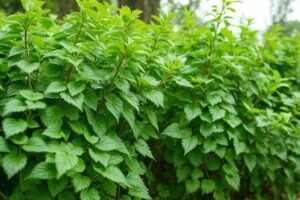The Role of Trees in Environmental Conservation
Trees play a crucial role in environmental conservation by providing a range of benefits. One of the primary contributions of trees is their ability to absorb and store carbon dioxide, a greenhouse gas responsible for global warming. Through the process of photosynthesis, trees absorb CO2 from the atmosphere, while simultaneously releasing oxygen. This not only helps combat climate change but also improves air quality, making trees a natural solution for reducing pollution in urban and rural areas.
Furthermore, trees are vital in maintaining the balance of ecosystems and supporting biodiversity. Forests provide habitats for a diverse range of plant and animal species, enabling them to thrive and maintain healthy populations. Additionally, trees help regulate water cycles by absorbing rainfall, preventing runoff and erosion. Moreover, their extensive root systems act as natural water filters, purifying water as it seeps through the soil. This vital ecosystem service is particularly important for ensuring the availability of clean, fresh water for both human and animal communities. In this way, trees not only protect the environment but also safeguard the well-being of all living beings that depend on them.
• Trees absorb and store carbon dioxide, helping combat climate change and improve air quality.
• Forests provide habitats for a diverse range of plant and animal species, supporting biodiversity.
• Trees regulate water cycles by absorbing rainfall, preventing runoff and erosion.
• Their root systems act as natural water filters, purifying water as it seeps through the soil.
• Trees protect the environment and safeguard the well-being of all living beings that depend on them.
Enhancing Air Quality through Tree Plantation
Air pollution is a pressing issue that affects the health and well-being of communities worldwide. One effective solution to combat air pollution is tree plantation. Trees play a vital role in enhancing air quality by acting as natural air filters. Through the process of photosynthesis, trees absorb carbon dioxide and release oxygen into the atmosphere. This helps to remove harmful pollutants such as carbon monoxide, sulfur dioxide, and nitrogen dioxide from the air, improving the overall air quality in the surrounding environment. Moreover, trees help to reduce the levels of particulate matter in the air by trapping dust and other airborne particles on their leaves and branches. Their presence in urban areas can significantly decrease the concentration of pollutants, making the air cleaner and healthier to breathe.
Not only do trees filter the air, but they also have the ability to reduce the levels of certain air pollutants. For instance, trees can absorb and sequester harmful gases like ozone and volatile organic compounds (VOCs). These pollutants are known to contribute to respiratory issues, cardiovascular problems, and other health concerns. By removing these pollutants from the air, trees offer a natural solution to improve air quality and protect human health. Additionally, trees also act as noise barriers, absorbing sound and reducing noise pollution in urban areas. This can have a positive impact on people’s mental well-being and overall quality of life. In conclusion, the practice of tree plantation plays a crucial role in enhancing air quality, making it an effective strategy to combat air pollution and create a healthier environment for all.
• Trees act as natural air filters through the process of photosynthesis
• They absorb carbon dioxide and release oxygen, removing harmful pollutants from the air
• Trees help to reduce levels of particulate matter by trapping dust and airborne particles on their leaves and branches
• Their presence in urban areas can significantly decrease pollutant concentrations, making the air cleaner to breathe
• Trees have the ability to absorb and sequester harmful gases like ozone and volatile organic compounds (VOCs)
• Removing these pollutants from the air helps improve air quality and protect human health
• Trees also act as noise barriers, absorbing sound and reducing noise pollution in urban areas
• This can have a positive impact on mental well-being and overall quality of life.
Mitigating Climate Change through Tree Planting
Tree planting plays a crucial role in mitigating climate change and reducing the accumulation of greenhouse gases in our atmosphere. As trees grow, they absorb carbon dioxide, one of the major contributors to global warming, through a process called photosynthesis. This process involves trees using sunlight and converting it into chemical energy, which is stored in their tissues. This energy is derived from carbon dioxide and water, and during this process, oxygen is released into the atmosphere as a byproduct. Therefore, by increasing the number of trees, we can effectively reduce the concentration of carbon dioxide in the air, helping to combat the adverse effects of climate change.
In addition to absorbing carbon dioxide, trees also serve as natural air purifiers. They filter out harmful pollutants from the air, such as sulfur dioxide, nitrogen oxides, and fine particulate matter. These pollutants are primarily emitted by human activities, including industrial operations, transportation, and the burning of fossil fuels. By strategically planting trees in urban areas, near industrial sites, and along roads, we can create healthier and cleaner environments. As these trees capture and trap pollutants in their leaves and bark, they help to improve air quality, reducing the negative impacts of pollution on human health and ecosystems. Tree planting, therefore, presents a simple yet effective solution for mitigating climate change and enhancing the quality of the air we breathe.
• Trees absorb carbon dioxide through photosynthesis, reducing greenhouse gas accumulation in the atmosphere.
• The process of photosynthesis converts sunlight into chemical energy stored in tree tissues.
• Oxygen is released as a byproduct of photosynthesis, helping to combat global warming.
• Increasing the number of trees can effectively reduce carbon dioxide concentrations in the air.
• Trees act as natural air purifiers, filtering out harmful pollutants from the atmosphere.
• Pollutants such as sulfur dioxide and nitrogen oxides are emitted by human activities like industry and transportation.
• Planting trees strategically in urban areas, near industrial sites, and along roads can create healthier environments.
• Trees capture and trap pollutants in their leaves and bark, improving air quality for humans and ecosystems.
Trees as Natural Water Filters and Erosion Controllers
Trees play a crucial role as natural water filters and erosion controllers, providing a range of benefits for both the environment and human populations. Through their root systems, trees help to stabilize the soil and prevent erosion by binding the soil particles together. This is especially important in areas prone to heavy rainfall or near water bodies where erosion can be a significant problem. Additionally, trees act as natural sponges, absorbing excess water and reducing the risk of flooding in flood-prone regions.
In terms of water filtration, trees have the ability to filter pollutants and impurities from water sources. As rainwater percolates through the soil, the roots of trees help to remove harmful substances and contaminants, ensuring that the water that reaches underground aquifers and rivers is cleaner and safer. This natural water filtration process is vital for maintaining the quality of our water resources and supporting diverse ecosystems. Additionally, the filtration function of trees also helps to recharge groundwater supplies, which are essential for drinking water and agricultural purposes. Overall, the presence of trees in an area contributes significantly to the protection and conservation of water resources.
• Trees stabilize the soil and prevent erosion by binding soil particles together
• They act as natural sponges, absorbing excess water and reducing the risk of flooding
• Trees filter pollutants and impurities from water sources as rainwater percolates through the soil
• Their roots help remove harmful substances and contaminants, ensuring cleaner and safer water reaches underground aquifers and rivers
• The filtration function of trees helps recharge groundwater supplies essential for drinking water and agriculture purposes
• The presence of trees in an area contributes significantly to the protection and conservation of water resources.
The Importance of Trees for Biodiversity and Wildlife
The presence of trees in our environment plays a vital role in supporting biodiversity and wildlife. Trees provide shelter and a conducive habitat for numerous species, creating a balanced ecosystem. The variety of tree species alone contributes to biodiversity as each species attracts different types of wildlife. Birds, insects, and small mammals find refuge in the branches and leaves of trees, creating a vibrant and diverse ecosystem that enhances the overall health of our environment.
In addition to providing shelter, trees also serve as a source of food and sustenance for wildlife. Fruits, nuts, seeds, and nectar produced by trees are essential food sources for many animals. Birds rely on tree branches to build their nests, while squirrels and other small mammals feast on the nuts and berries that trees bear. The dependence of various species on trees for their survival strengthens the intricate web of interactions that make up our ecosystems, ensuring the continuity of life.
• Trees provide shelter and a conducive habitat for numerous species, creating a balanced ecosystem.
• The variety of tree species alone contributes to biodiversity as each species attracts different types of wildlife.
• Birds, insects, and small mammals find refuge in the branches and leaves of trees, creating a vibrant and diverse ecosystem that enhances the overall health of our environment.
• Fruits, nuts, seeds, and nectar produced by trees are essential food sources for many animals.
• Birds rely on tree branches to build their nests while squirrels and other small mammals feast on the nuts and berries that trees bear.
• The dependence of various species on trees for their survival strengthens the intricate web of interactions that make up our ecosystems.
Trees as Providers of Food, Medicine, and Raw Materials
Trees play a vital role in providing us with a diverse range of resources that are essential for our well-being. One of the most significant contributions of trees is their ability to provide us with food. Trees such as fruit trees, nut trees, and even certain leaves are a valuable source of nourishment. Not only do they offer us a variety of flavors, but they also provide us with essential vitamins and minerals necessary for a healthy diet. From apples and oranges to almonds and walnuts, trees offer a bounty of nutritious options.
In addition to food, trees also provide us with medicine and raw materials that are crucial for various industries. Many trees possess medicinal properties, with extracts from their leaves, bark, or roots used to develop drugs and treatments for various ailments. Moreover, trees also supply us with raw materials like wood, which is utilized in construction, furniture making, and paper production. Furthermore, trees are a source of natural resins, oils, and fibers, which find application in cosmetic, pharmaceutical, and textile industries. The availability of these resources highlights the immense value trees hold in our daily lives.
• Trees provide us with a diverse range of food options, including fruits, nuts, and leaves.
• These food sources offer a variety of flavors and essential vitamins and minerals for a healthy diet.
• Examples of tree-based foods include apples, oranges, almonds, and walnuts.
• Many trees possess medicinal properties, with extracts from their leaves, bark, or roots used to develop drugs and treatments for various ailments.
• The availability of these medicinal resources highlights the importance of trees in healthcare industries.
• Trees also supply us with raw materials like wood that are crucial for construction projects, furniture making, and paper production.
• Natural resins from trees are used in cosmetic products while oils find application in pharmaceuticals. Fibers from trees are utilized in the textile industry.
Economic Benefits of Tree Plantation for Future Generations
Economic Benefits of Tree Plantation for Future Generations
Trees have always been a valuable resource, and their economic benefits extend far into the future. One of the key advantages of tree plantation is the potential for timber production. As trees grow and mature, they provide a sustainable source of wood that can be utilized for various purposes. From construction materials to furniture production and paper manufacturing, the demand for timber will only increase with time. By investing in tree plantation today, we are ensuring a continuous supply of valuable timber for future generations, reducing dependence on unsustainable methods of logging and promoting a more sustainable and economically viable future.
Additionally, tree plantation offers numerous economic benefits through the creation of jobs and income opportunities. As the demand for tree-related products and services grows, so does the need for skilled labor in forestry and related industries. From tree planting and management to harvesting, processing, and transportation, the entire supply chain of the tree industry provides employment for the local communities. Moreover, sustainable tree plantation can also support small-scale entrepreneurial ventures, such as eco-tourism or the production of value-added products derived from trees. These economic avenues not only contribute to the prosperity of present generations but also lay the foundation for a sustainable economic future for generations to come.
• Tree plantation ensures a continuous supply of timber for future generations, reducing dependence on unsustainable logging methods.
• Timber production from trees can be used in construction materials, furniture production, and paper manufacturing.
• The demand for timber will only increase with time, making tree plantation a valuable investment.
• Tree plantation creates jobs and income opportunities in forestry and related industries.
• Skilled labor is needed for activities such as tree planting, management, harvesting, processing, and transportation.
• The entire supply chain of the tree industry provides employment for local communities.
• Sustainable tree plantation supports small-scale entrepreneurial ventures like eco-tourism or value-added products derived from trees.
• These economic avenues contribute to the prosperity of present generations while laying the foundation for a sustainable economic future.
Trees and Their Contribution to Mental and Physical Health
Trees have long been recognized for their positive impact on mental and physical health. Spending time in nature has been found to reduce stress, anxiety, and depression, and trees play a vital role in creating these soothing environments. The fresh air provided by trees can improve respiratory health, while the shade they offer can protect individuals from harmful UV rays. Moreover, the visual presence of trees has been shown to promote relaxation and enhance overall well-being. Whether it’s taking a peaceful walk in a forest or simply enjoying the sight of trees from a window, incorporating trees into our surroundings can contribute significantly to our mental and physical health.
Additionally, trees also have the potential to improve cognitive functioning. Research has shown that exposure to nature, particularly areas with trees, can enhance concentration, attention, and memory. The calming effect of trees can boost productivity and creativity, making them beneficial not only for individuals but also in educational and work settings. Furthermore, trees act as natural sound barriers, reducing noise pollution and creating a peaceful environment that can improve sleep quality and overall restfulness. As such, trees offer a natural and readily available solution for promoting mental and physical well-being in our communities.
• Spending time in nature, including among trees, can reduce stress, anxiety, and depression.
• Trees provide fresh air that improves respiratory health.
• The shade offered by trees protects individuals from harmful UV rays.
• The visual presence of trees promotes relaxation and enhances overall well-being.
• Incorporating trees into our surroundings significantly contributes to mental and physical health.
• Exposure to nature with trees enhances concentration, attention, and memory.
• Trees have a calming effect that boosts productivity and creativity in educational and work settings.
• Trees act as natural sound barriers, reducing noise pollution for better sleep quality.
• Trees offer a natural solution for promoting mental and physical well-being in communities.
Trees as Community Enhancers and Social Spaces
Trees play a crucial role in enhancing communities and providing social spaces for people to gather and connect. In urban areas, where green spaces are often limited, trees can create a sense of belonging and provide much-needed respite from the concrete jungle. Parks and tree-lined streets offer a sanctuary where individuals can escape the hustle and bustle of daily life, relax, and engage in recreational activities. Whether it’s enjoying a picnic under the shade of a tree, playing sports on a grassy field, or simply taking a leisurely stroll, these green spaces contribute to the overall well-being of the community.
Moreover, trees act as natural meeting points, fostering social interactions and a sense of community. They create a welcoming environment for neighbors to come together, forge friendships, and engage in communal activities. Community events, such as festivals, concerts, and markets, thrive under the canopy of trees, creating vibrant spaces that encourage social cohesion. In addition, trees can serve as landmarks, contributing to the identity and character of a neighborhood or town. They become gathering spots for locals, where stories are shared, traditions are celebrated, and memories are made. These community-enhancing qualities of trees not only enrich the lives of individuals but also strengthen the social fabric of our society.
• Trees in urban areas create a sense of belonging and provide respite from the concrete jungle.
• Parks and tree-lined streets offer a sanctuary for relaxation and recreational activities.
• Green spaces contribute to the overall well-being of the community.
• Trees act as natural meeting points, fostering social interactions and a sense of community.
• They create a welcoming environment for neighbors to come together, forge friendships, and engage in communal activities.
• Community events thrive under the canopy of trees, creating vibrant spaces that encourage social cohesion.
• Trees can serve as landmarks, contributing to the identity and character of a neighborhood or town.
• They become gathering spots for locals where stories are shared, traditions are celebrated, and memories are made.
Cultivating a Culture of Tree Planting for a Sustainable Future
Trees play a vital role in maintaining a sustainable future. Cultivating a culture of tree planting is crucial for preserving and improving our environment. By actively participating in tree planting initiatives, individuals, communities, and governments can take significant steps towards a greener and healthier planet.
One of the key benefits of cultivating a culture of tree planting is the positive impact it has on reducing carbon emissions. Trees act as natural carbon sinks, absorbing carbon dioxide from the atmosphere and releasing oxygen. By planting more trees, we can mitigate climate change and contribute to the global effort to reduce greenhouse gas emissions. Moreover, trees also help to cool the environment by providing shade and reducing the need for energy-intensive air conditioning systems, further aiding in our quest for a sustainable future.
Promoting a culture of tree planting is not only about environmental conservation; it also positively impacts our social and economic well-being. Communities with a higher tree cover experience enhanced social spaces and improved mental and physical health. Trees act as natural noise barriers, creating a tranquil environment that can reduce stress and anxiety. Additionally, tree planting initiatives can foster a sense of community cohesion, as individuals come together to work towards a shared goal of a greener future. Furthermore, trees provide economic benefits by offering a sustainable source of food, medicine, and raw materials, empowering communities to be self-reliant and economically prosperous.
In conclusion, cultivating a culture of tree planting is fundamental for a sustainable future. By recognizing the various contributions that trees make to our environment, society, and economy, we can inspire individuals to actively engage in planting and nurturing trees. It is essential that we collectively take responsibility and embrace this culture, for it is through our actions that we can envision a greener, healthier, and more sustainable world for generations to come.
• Trees act as natural carbon sinks, absorbing carbon dioxide from the atmosphere and releasing oxygen.
• Planting more trees can mitigate climate change and contribute to the global effort to reduce greenhouse gas emissions.
• Trees help cool the environment by providing shade and reducing the need for energy-intensive air conditioning systems.
• Communities with a higher tree cover experience enhanced social spaces and improved mental and physical health.
• Trees act as natural noise barriers, creating a tranquil environment that can reduce stress and anxiety.
• Tree planting initiatives foster a sense of community cohesion as individuals work towards a shared goal of a greener future.
• Trees provide economic benefits by offering a sustainable source of food, medicine, and raw materials.
• Cultivating a culture of tree planting empowers communities to be self-reliant and economically prosperous.












